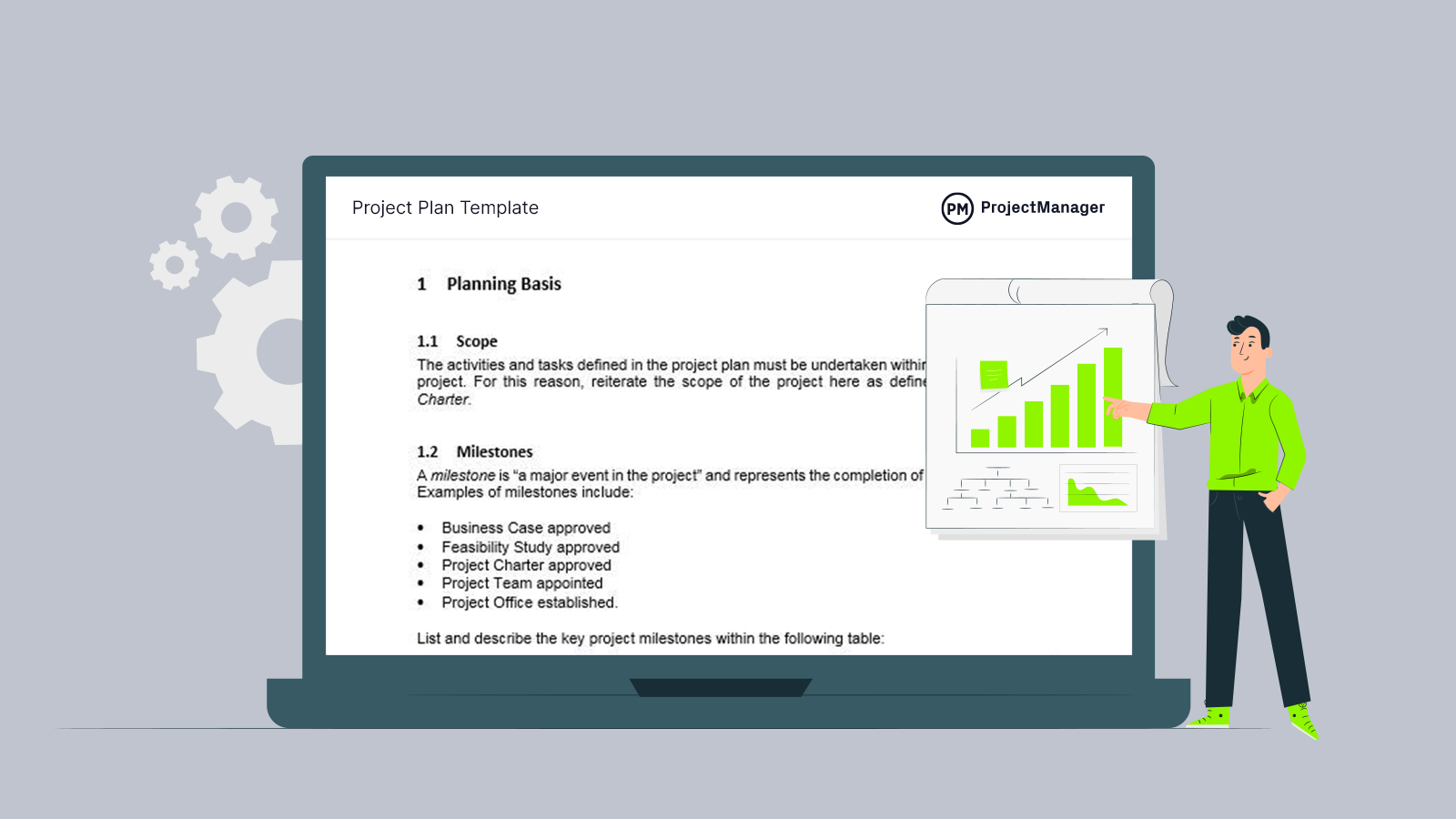Download this free project plan template for Word to scope your work and break it down into manageable components; then schedule and assign the tasks needed to complete your project.
You can also use this project management plan template to manage workloads and tasks as changes occur. A project plan is the foundation of the work you do to lead a project to successful completion.
Once everything is sorted on the Word doc, open ProjectManager’s free project plan template. It lets you build a dynamic project plan that can be managed in five different project views: Gantt chart, task list, kanban board, calendar and spreadsheet. Plus, your team can collaborate on the project in real time and track progress along the way with dashboards and instant status reports. Get started for free with ProjectManager and build a better project plan.
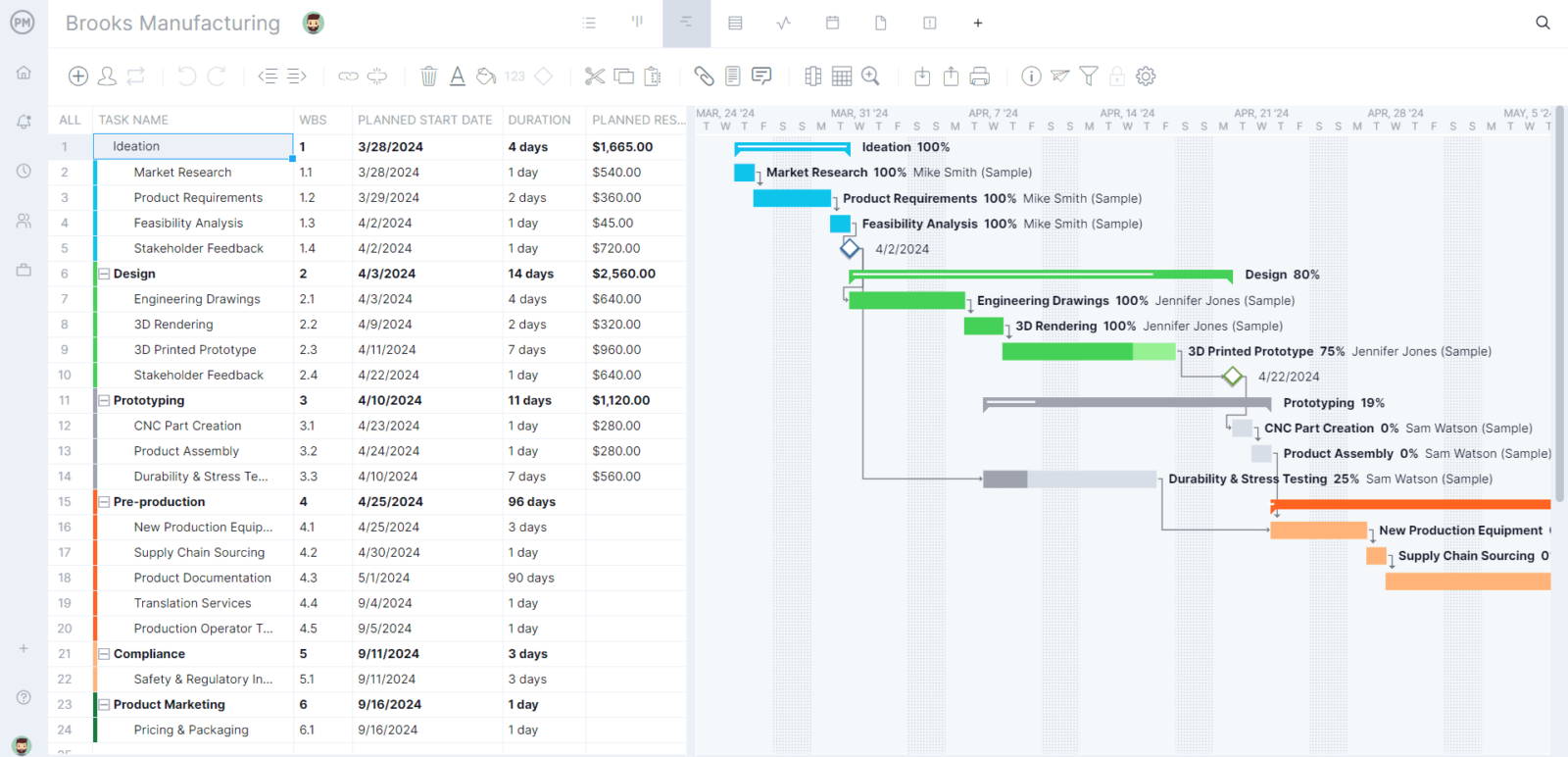
What Is a Project Plan Template?
A project plan template is a document that compiles all the guidelines and procedures the project management team needs to execute a project. Project plan templates allow project managers to save time during the project planning phase and also help them ensure nothing slips through the cracks.
When Do I Use the Project Plan Template?
The project management life cycle is made up of five phases: the initiation phase, the planning phase, the execution phase, the monitoring and the closure phase. This project plan template should be filled out during the project planning stage, but it’s also helpful throughout the project execution and monitoring and closure phases.

However, it can be argued that the process of making a project plan begins during the initiation phase, because during this phase many documents are created to set up the project plan, such as a feasibility study to identify the problem you want to solve, the scope of the project and the deliverables you want.
This feeds into the business case, which compares costs versus benefits. The statement of work (SOW) looks at the project goals, objectives, scope and deliverables. These don’t constitute a project plan, but they do lay the foundation on which you’ll build your plan. This is when you take the broad strokes from the initiation phase and break it down into smaller, more manageable tasks. Each of these tasks must be achieved within the project timeframe.
Who Uses the Project Plan Template?
It’s important to note that the project manager is tasked with the ownership of creating the project plan, but work isn’t done in isolation.
- Project Manager: The project manager must work in congress with the team, experts and others who can provide insight and guidance into developing a realistic project management plan.
- Project Team Members: Teams are assembled for their skills and experience working on such projects, so it makes sense that you need ideas on how to plan the project. Of course, the team will have access to the project plan template throughout the execution phase of the project. They’ll be assigned tasks and be responsible for delivering them on time and within budget.
- Project Stakeholders: Others who will use the project plan include stakeholders and executives, or anyone with a vested interest in the successful outcome of the project. The project manager will present to these groups throughout the project life cycle to keep them abreast of progress and ensure that actual progress matches what’s been outlined in the project plan.
- Project Management Office (PMO): A project management office (PMO) uses a project planning template to ensure consistent project planning across all projects throughout the organization. It’s an efficient way to enforce best practices and is a way to create visual representations of project milestones, timelines and dependencies. Many PMOs will use a project planning template to facilitate collaboration as it’s ideal for the team to reference during discussions and when making decisions.
- Department Heads and Functional Managers: Another example is a department head or functional manager using a project management plan template during the planning and tracking phases. For example, it allows them to better assign resources to specific tasks and establish deadlines for tasks and milestones. It can also help with risk assessment and task prioritization.
How to Use This Project Plan Template
Project planning starts with a thorough project plan document. This project plan template allows you to make a thorough project management plan for any type of project.
To simplify things, let’s break down the project plan template into 5 sections:
- Project Plan Template Section 1: Purpose, Goals, Success Criteria and Governance
- Project Plan Template Section 2: Team Management and Stakeholder Management
- Project Plan Template Section 3: Scope Management and Project Schedule
- Project Plan Template Section 4: Resources, Procurement, Budget and Cost Management
- Project Plan Template Section 5: Changes and Risks
Project Plan Template Section 1: Purpose, Goals and Success Criteria
In this first section of the project plan template, you’ll define its purpose, goals, and the criteria to evaluate whether it was successful or not once it’s completed.
Project Purpose, Goals and Objectives
What is the purpose of the project? The template includes a space to add the purpose in addition to the project goals and objectives. This is an overview section that provides a high-level overview.
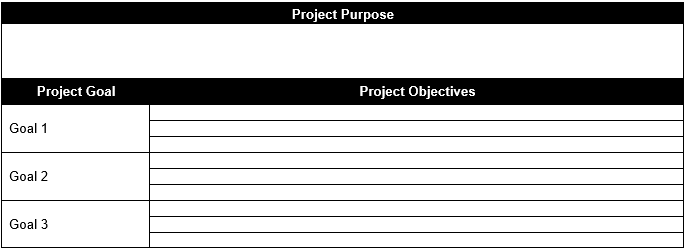
Project Success Criteria
Determine what will make this particular project successful. These success criteria standards vary based on the project, but they typically include considerations like time, cost and scope. Additional criteria considerations include quality, risk management, stakeholder satisfaction, business value, regulatory compliance and customer satisfaction, to name a few.
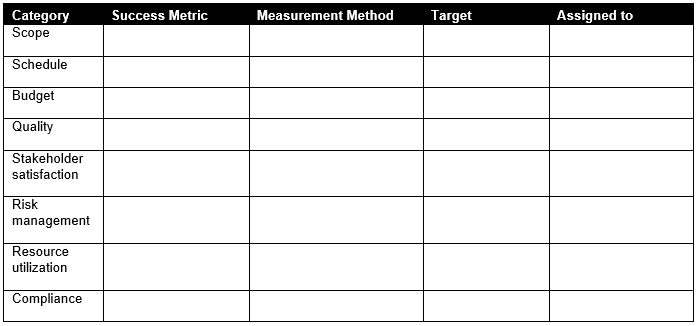
Project Plan Template Section 2: Project Team, Governance, Stakeholders & Communications
In this section you’ll identify project stakeholders and the members of the project team and will also define the governance and communication guidelines to engage both of these parties.
Project Team
List the members of the project team who will be involved in this particular project, including their name, role and responsibilities to better understand what’s expected of them.

Project Governance
Here, outline the framework, processes and mechanisms for accountability and decision-making throughout the project. This helps the project align with the organization’s strategic goals so that it’s managed effectively.

Project Stakeholders
A stakeholder management plan helps identify project stakeholders, manage their expectations and address any concerns they may have.
While the contents of a stakeholder management plan will vary from one project to another, at a basic level it should include a stakeholder register and a stakeholder map.
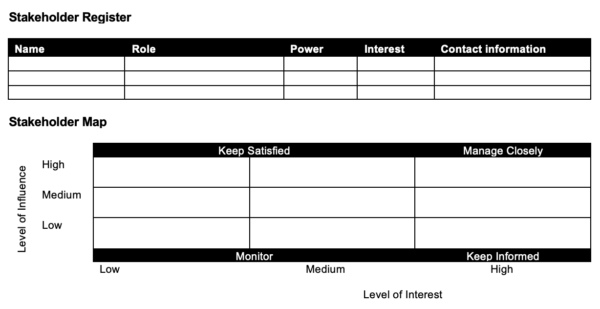
- Stakeholder Register: The stakeholder register section of the project plan template lists all individuals or groups who may have an interest in a project.
- Stakeholder Map: A stakeholder map visually represents the groups or individuals with a vested interest in the project and helps develop a strategy for stakeholder management.
- Stakeholder Engagement Strategies: Once you’ve registered and prioritized project stakeholders, list some effective stakeholder engagement strategies including communication style, involvement and participation, relationship building and conflict and resolution.
Project Communication Plan
Last but certainly not least in the project planning template is the project communication plan. This is an opportunity to outline key communication facets that will be present throughout the project.
- Project Reports & Reporting Frequency: Define what type of project reports will be produced and how often they will be generated.
- Project Meetings: Will project meetings occur consistently throughout the project? Define the type of meetings and how often they will occur.
- Project Documentation: Finally, note any project documentation including a project charter, work breakdown structure, resource plan, project schedule, change management plan, etc.
Project Plan Template Section 3: Project Scope, Quality and Project Schedule
In this section, you’ll define the work that will be performed, the quality standards for project deliverables and the timeline for the completion of tasks.
Project Scope
Begin by defining the project scope, which is all the tasks that will be executed to complete the project. In addition to outlining project tasks, the project scope also describes the deliverables and milestones expected from those tasks.
- Scope Baseline: Once a task list has been defined, it is utilized as a scope baseline, which helps project managers set boundaries for the project scope and ensure no additional work is added to the project plan during the project execution phase.
- Project Milestones: Milestones are major events in your project, which are reached by completing tasks, such as reaching an objective or producing a key deliverable.
- Exclusions: Work that will not be completed as part of the project scope.
- Assumptions: Assumptions are certain conditions that are believed to be true and have the potential to affect the project scope, both positively or negatively.

Project Quality
The quality management plan section of the project plan template describes the quality standards for project deliverables, the quality assurance guidelines that will be followed and the quality control methods for testing whether quality standards are met.
- Quality Standards: These are the criteria and benchmarks that measure the quality of a project’s processes and deliverables. They enable the project to meet stakeholder expectations.
- Quality Assurance Guidelines: Next are quality assurance guidelines that help define quality standards and establish quality control procedures. These guidelines can help improve customer and stakeholder satisfaction.
- Quality Control Procedures: List the specific actions that you’ll take to ensure the product, service or process meets the predetermined quality standards.
Project Schedule
The project schedule indicates when the project tasks defined in the scope management section will be executed, including task dependencies, milestones and key deliverables. A Gantt chart is the perfect project management tool to easily visualize these and other details of the project schedule, such as the critical path of the project.
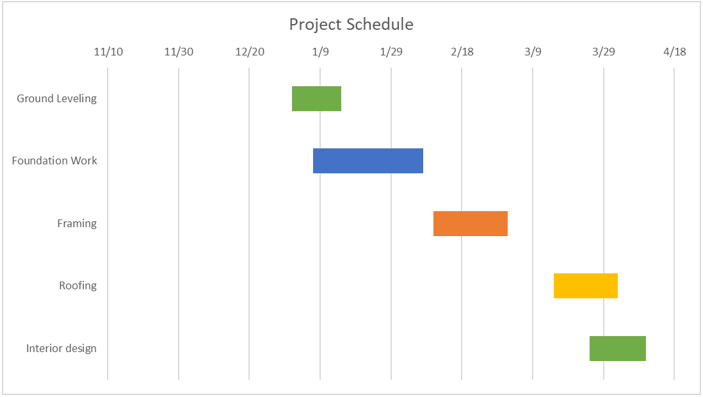
A project schedule should also indicate when resources will be needed, although some project managers prefer to create a separate resource schedule.
Project Plan Template Section 4: Resources, Procurement, Budget and Cost Management
Now that the project scope has been defined, it’s time to consider what resources will be required to complete the project, how they’ll be procured, what the budget will be and what measures will be taken to monitor costs.
Resources
This leads to the effort likely needed to complete the above tasks. List the task with the amount of time you believe necessary to finish the task. This in turn goes hand in glove with resources, so you want to take the task and attach a resource or team member to it. This is the person responsible for completing the task.
Procurement Management Plan
In the procurement management plan section of the template, you’ll outline the strategies and processes for acquiring external sources for a project.
- Vendor selection process: What vendors are the best fit for the job? To select the right vendor, define the project requirements, evaluate proposals, conduct interviews and negotiate contracts.
- Procurement schedule: This is a detailed timeline that outlines the deadlines, responsibilities and activities that will take place during the procurement process.
Project Budget
The project budget is one of the most critical components of any project plan template. That’s because the project budget determines the amount of money available for your project. Therefore, you need to be very careful when creating yours.
First, gather your project tasks, identify the resource requirements for each and lastly estimate their costs. Once you have the costs for each project task, you can add them to get your estimated project cost value. That value will be your cost baseline and the base for your project budget.

Cost Management Plan
Another important part of a project management plan template is a cost management plan. It describes the processes and procedures that will help plan, estimate, budget and control project costs.
- Cost Estimation Methodology: There are various methods for estimating project costs, such as analogous estimating, parametric estimating and bottom-up estimating, each of which have pros and cons depending on the project.
- Cash Flow Projections: These financial forecasts estimate the future cash outflows and inflows for a specific time.
- Cost Control Processes, Tools and Techniques: These work in tandem to help the project stay within budget. Some processes include cost estimating or cost control. Tools and techniques may include earned value management, budgeting techniques or cost control techniques.
Project Plan Template Section 5: Change and Risk Management
Now it’s time to identify how to manage any changes or risks that could suddenly impact the project plan.
Change Management Plan
Every project plan needs to be changed during the execution phase for several reasons. For example, new project requirements might arise and cause changes to the original plan. As a project manager, you must oversee how changes are made to your project.
- Change Control Board: This is a formal group that reviews, evaluates and approves or rejects any proposed project changes. This is especially critical for long-term and complex projects.
- Change Order Request Form: Use the change order request form as a way to better manage changes to the project and minimize their impact to the scope, schedule and budget.
- Change Log: Our change management log helps you keep track of any changes made to your project plan.
Risk Management Plan
Every project plan template needs a risk management plan. This is a section that identifies any potential risks that might affect the project plan, prioritizes them, defines risk mitigation activities and establishes the roles and responsibilities of the team.
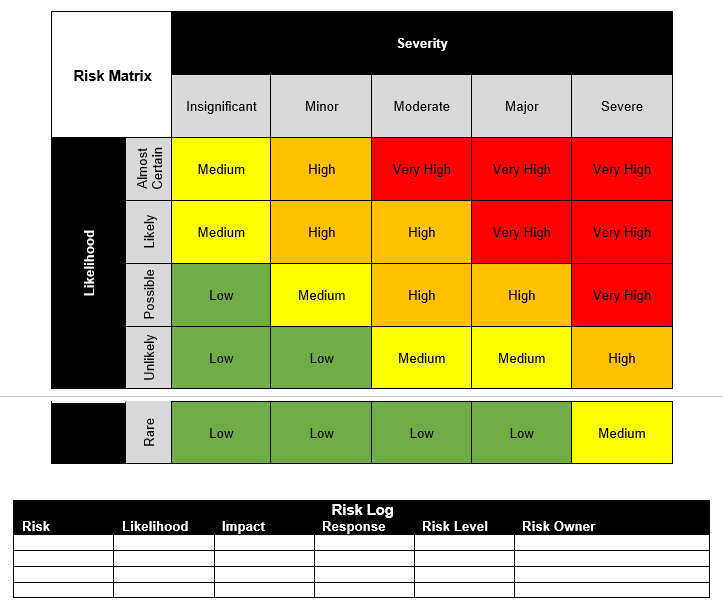
- Risk Matrix: A risk matrix is a visual representation of the potential project risks based on their likelihood and impact. It makes it easy to see what risks are pressing and what risks likely won’t come to fruition.
- Risk Log: Our project plan template has a risk log so you can list the potential risks that could affect your project plan. From there you can develop your risk mitigation strategies and assign risk owners.
- Risk Mitigation Strategies: Various techniques can be used to reduce the impact or likelihood of a risk occurring. Some examples include risk reduction, risk avoidance or risk acceptance.
Appendix
Each project management plan is unique, and the components of the project plan template might vary depending on the requirements of your project. Some projects might require additional project documentation.
Why You Need a Project Plan Template
Now that you’ve downloaded the free project plan template, you are ready to get your project on track to a successful completion! The project plan is crucial, as it is the fundamental project planning document from which your project is formally managed.
The project plan is made up of goals, activities, tasks and resources needed to complete the project as outlined in the project business case and the project charter. You want to have a description of the major phases of the project, a schedule of activities, tasks and their duration, dependencies, resources, timeframes, etc. Then list the assumptions and constraints in the project planning process.
When you’re creating a project management plan, follow these steps: note the project scope, identify milestones and tasks, estimate costs, quantify the effort required, allocate the resources, make a schedule, list dependencies and document it for approval. Your project management plan template needs to incorporate components such as the scope management plan, cost management plan and schedule management plan, among others.
While the business case from earlier in the project planning process may offer a general project view, the project plan goes into greater detail once the project scope and charter are formalized and a team is hired. Although you write the project plan during the project planning phase, it doesn’t stay in a drawer once complete. This project plan template should be considered a living document that’ll be revisited and referred to throughout the project life cycle. This is because the project management plan is a roadmap that project managers use during the execution phase when they need information about the project schedule, costs, scope and budget.
Once your document is finalized, it’s time to build a dynamic project plan and schedule. Project planning software can help you transfer your project plan onto a Gantt chart so you can create a timeline, schedule work, design phases, attach documents and track progress along the way. Then share the plan with your team, who can use multiple project views, such as the task list, sheet, calendar and kanban board.
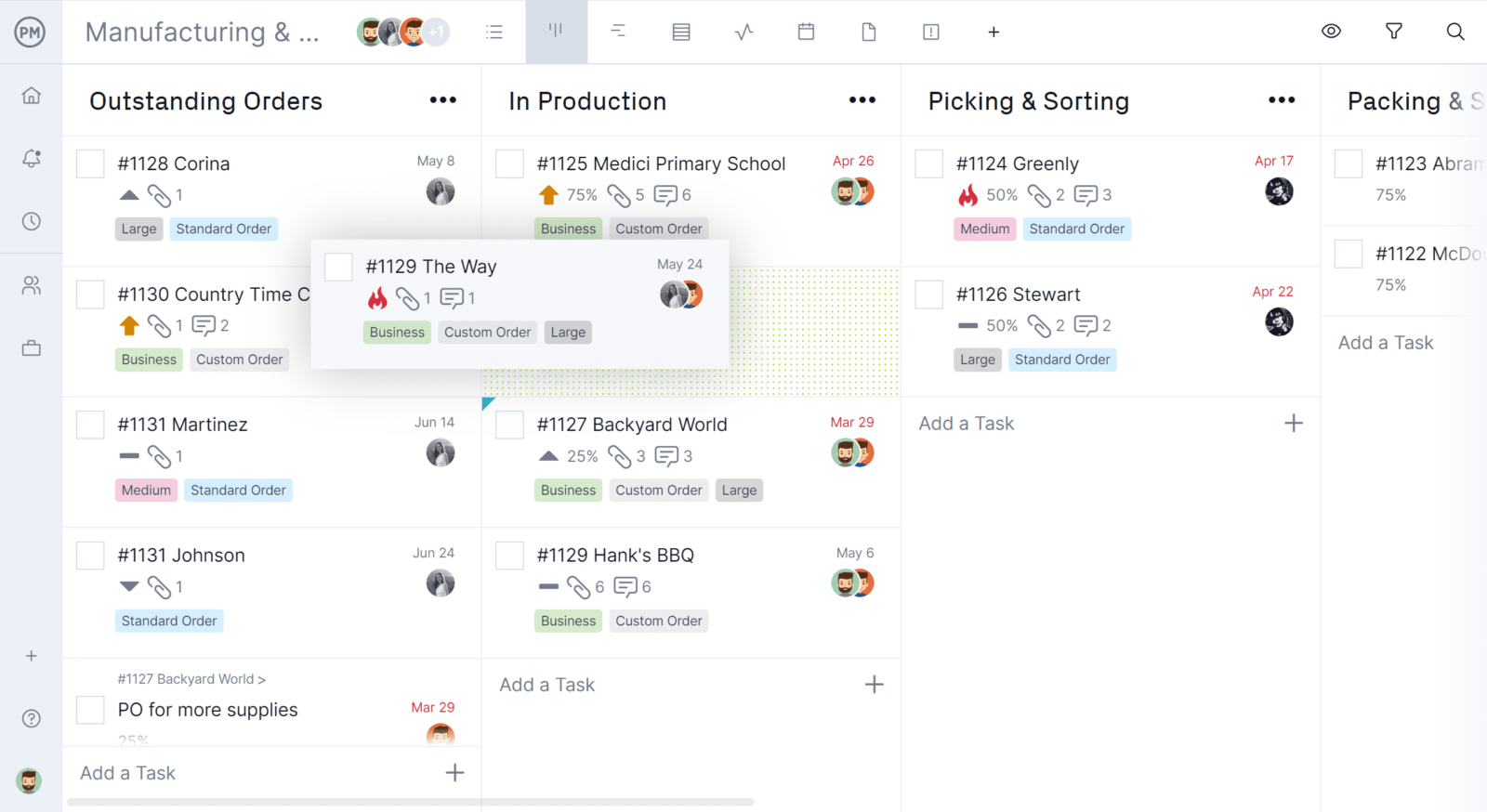
Free Project Management Templates
There are dozens of free project management templates for Word and Excel available on our site. Some of them are useful during the project planning process. Here are a few that can help further build your project plan template.
Action Plan Template
Your project plan has to align with a larger strategy which is outlined in an action plan. The free action plan template provides you with a space to lay out the needed steps and concrete tasks to reach your project goal. The action plan gives you a frame in which to capture the main thrust of the project to help you prioritize tasks in your plan.
Gantt Chart Template
The Gantt chart is the workhorse of project management planning. It’s a visual tool that organizes your tasks on a timeline. It helps you prioritize and set durations for each task, shows phases and breaks up larger projects into more manageable phases.
WBS Template
Another key tool when building your project schedule is the work breakdown structure (WBS). This is a technique for working backward from your final deliverable to outline each step that gets you there. It’s a thorough way to make sure you don’t miss any puzzle pieces of your larger project. This project management template takes you through that process.
Related Content
Now that you’ve downloaded your free project management plan template and it reflects your project plan, you’re ready for the job at hand. But, whether you’re a project management journeyman or apprentice, you never want to stay complacent. Industries and businesses don’t stand still, and you have to do your best to stay up-to-date on new trends.
There are many free project management templates and topics of discussion on ProjectManager that can be easily filtered to bring you the content that’s most relevant to your interests. Subjects include, but aren’t limited to, project management software, scheduling, risk and task management, collaboration, time tracking, Gantt charts, reporting and, of course, planning.
As the subject at hand is our project plan template, we’ve compiled three of the most recent and relevant posts on project planning. Enjoy!
Try ProjectManager Free for 30 Days
ProjectManager is a great project planning tool. It offers the features you need to plan, track and report on your project. There are online and interactive Gantt charts that take the pain out of having to build one manually.
The software is also online so it’s easy to access from anywhere and on any device. Better still, it makes sharing necessary documents and tasks easy, and both the project manager and team members can get automated notifications to streamline the reporting process.
Why not plan your next project on ProjectManager? Our project management software is big enough to handle the largest and most complex project planning challenges while being user-friendly and intuitive. There’s no learning curve or long and involved training involved, and a team of customer service reps is available to answer any question you may have. Sign up for a free 30-day trial today and start planning your projects online.
